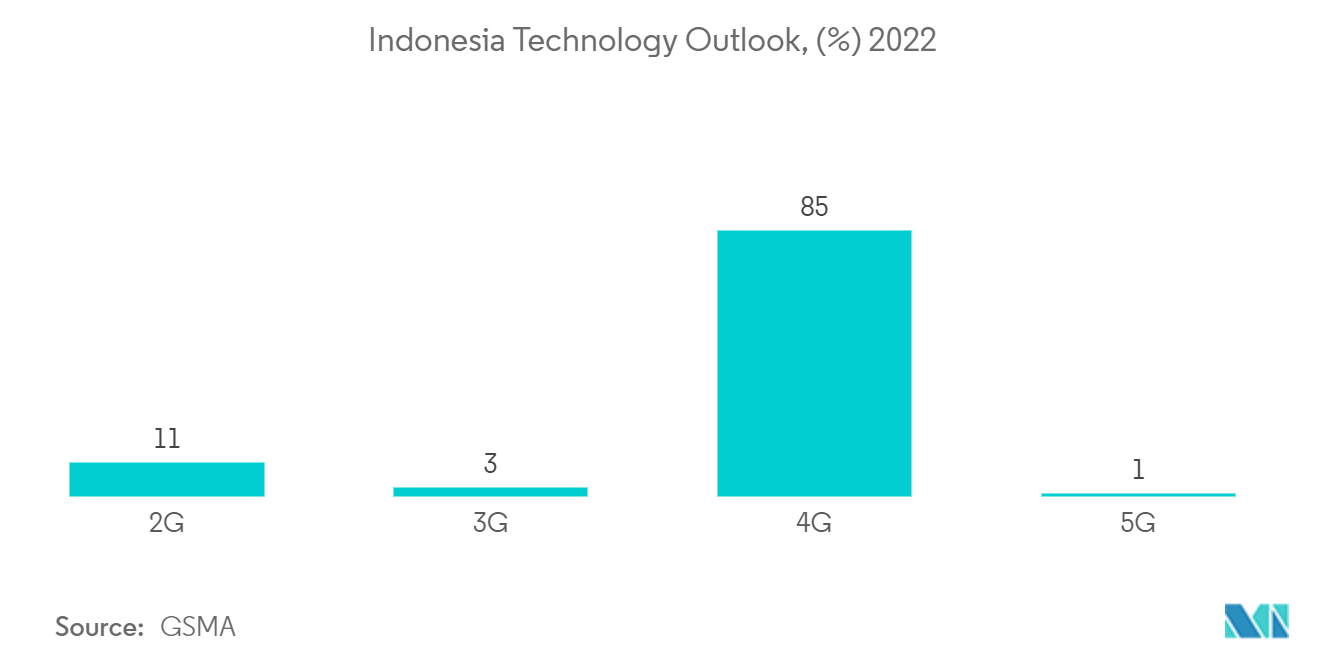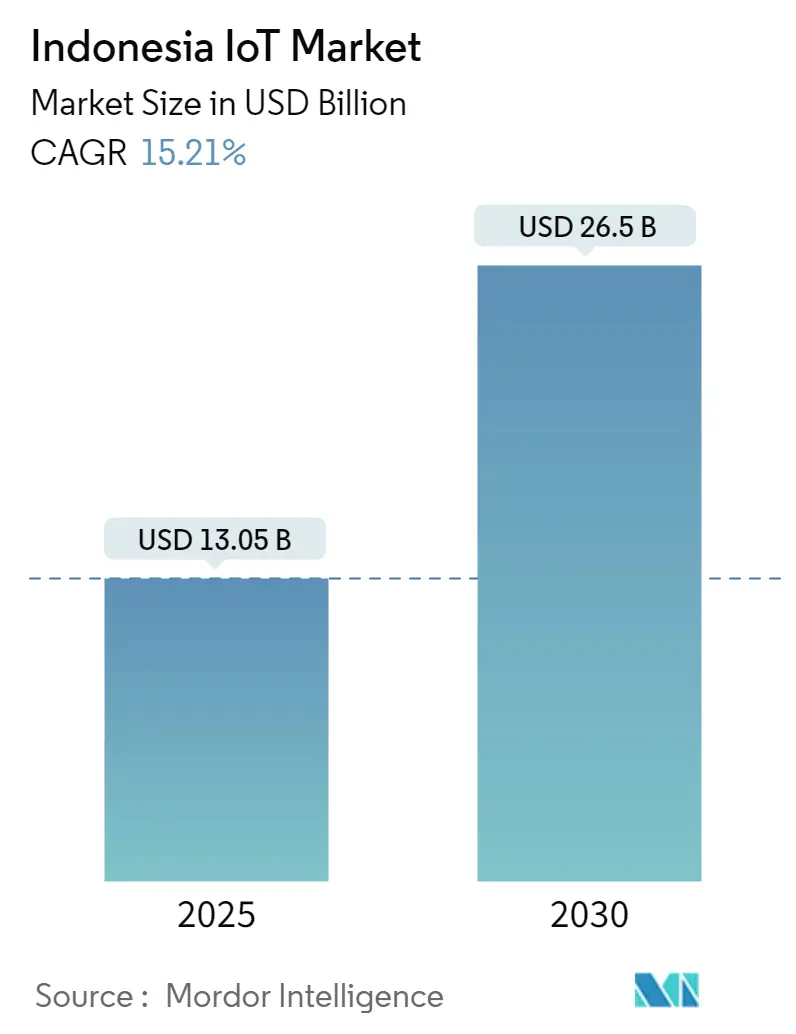
| Study Period | 2019 - 2030 |
| Base Year For Estimation | 2024 |
| Forecast Data Period | 2025 - 2030 |
| Market Size (2025) | USD 13.05 Billion |
| Market Size (2030) | USD 26.50 Billion |
| CAGR (2025 - 2030) | 15.21 % |
| Market Concentration | Low |
Major Players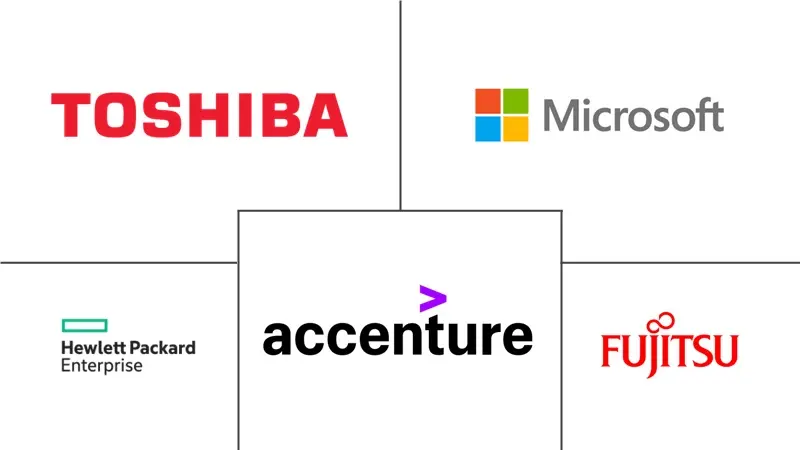
*Disclaimer: Major Players sorted in no particular order |
Indonesia IoT Market Analysis
The Indonesia IoT Market size is estimated at USD 13.05 billion in 2025, and is expected to reach USD 26.50 billion by 2030, at a CAGR of 15.21% during the forecast period (2025-2030).
IoT includes a wide range of devices connected to the internet that facilitate better services and offer an easier life to customers. The Internet of Things (IoT) has emerged as a widely used technology used by many people and companies across Indonesia.
- The rising proliferation of smartphones, Internet connectivity, technological advancements, and increasing e-commerce are some factors driving the IoT market in Indonesia. The State Cyber and Password Agency (BSSN) in Indonesia stated a significant rise in Internet of Things (IoT) users compared to the number of connected smartphone users. Therefore, it is evident that the development of IoT in Indonesia is becoming more and more widespread.
- Last year, the Ministry of Communication and Informatics (Kemkominfo) and the Indonesian Internet of Things Association (ASIOTI) held the IoT Creation Program to encourage the formation of local startups focusing on developing IoT devices and solutions.
- Indonesia is anticipated to witness an acceleration in implementing IoT-based solutions across various industry verticals. For instance, in the healthcare sector, IoT devices help monitor blood pressure and glucose levels and allow physicians to make swift diagnoses and real-time decisions to benefit patients. In the military industry, IoT is used in drones for territorial surveillance of Indonesian territory. Rise of Industrial Revolution 4.0. has increased the demand for IoT to address the challenges in logistics, financial transactions, manufacturing, and others. Businesses in Indonesia are widely adopting IoT in intelligent buildings and smart offices.
- The Indonesian government is actively investing in the construction of smart cities. The development of digital technology has accelerated the country's smart city concept and trend. Digital disruption is changing how governments manage organizations and solve problems in the community. The smart city is anticipated to open up new regional investment opportunities.
- The Indonesian IoT market has become more robust in the post-COVID-19 era. It has opened new business opportunities and revenue streams, improved business management, and facilitated new service delivery across fields. Demand for the Internet of Medical Things has increased among medical professionals to collect and analyze patient data. Medical clinics increasingly rely on direct messaging software to contact patients. Public infrastructures utilize IoT to manage health crises and climate disasters and maintain effective city networks. The rise of an increasingly interconnected and digitized world will likely increase Indonesia's demand for IoT hardware, software, and services.
Indonesia IoT Market Trends
Software segment to hold a significant market share
- The Internet of Things (IoT) software allows smart devices to interchange information across a network infrastructure. IoT software assists in integrating physical tasks into computer-based structures, resulting in better precision and reduced human engagement. IoT software is gaining widespread adoption among Indonesian consumers, industries, and governments to leverage the advantages of connecting devices across the Internet infrastructure. The growing proliferation of smartphones, connected cars, and wearable devices, among others, will likely propel the segment's growth.
- Indonesia has reflected higher smartphone adoption and digital skills in recent years. The availability of low-power wide area networks (LPWANs), including narrowband IoT (NB-IoT) networks, low-range wide area networks (LoRaWANs), and Sigfox networks, is driving the country's IoT deployments. Sigfox is the most developing of the LPWA technologies, which was recently launched in Indonesia.
- IoT deployments are underway across the utility sector in Indonesia. The rising number of device manufacturers supporting IoT deployments, such as smart meters, is propelling the segment growth in the country. Advanced IoT strategies adopted by the country's mobile operators accelerate IoT software deployments. The roll-out of LPWANs and the end-to-end solutions offered by mobile operators across multiple use cases further strengthen the country's IoT ecosystem.
- Organizations in Indonesia are strategically focusing on staying ahead of the competition regarding the quality of their IoT experience. IoT software enables the storage, processing, data collection, manipulation, and instruction, which is helping companies in the market to gain a competitive advantage. Indonesia's digital connectivity vendors are developing innovative digital platforms that open a world of opportunities for the nation. They are partnering with experts to provide customers with the best-in-class digital experiences and replace inefficient legacy platforms.
- In Indonesia, the adoption of 5G technology and 5G Fixed Wireless Access (FWA) is growing with the potential to drive incremental revenue opportunities for operators. The increase in 5G networks and the growing number of connected devices will propel Indonesia's Internet of Things (IoT) market growth. 5G technology is expected to reduce latency significantly faster than 4G. Therefore, IoT devices will be able to communicate in real time, allowing for faster decisions and more efficient operations.
Industrial IoT to witness a significant growth
- Industrial IoT platform utilizes image recognition, extensive data analysis, and software-defined networking (SDN) to automate and optimize production lines and analyze collected data. In the Industrial Revolution era, technologies such as IoT are shifting production and reshaping the business model of manufacturing companies in Indonesia, creating greater efficiency. Industrial IoT is enabling manufacturing innovation and digital transformation for the manufacturing companies in the country. Indonesia has recorded rapid growth in GDP in recent years, which is supported by its growing start-up ecosystem.
- The Indonesian Stock Exchange includes notable listings of regional tech giants. The country is witnessing increasing innovation in areas like IoT to seek new opportunities. Government initiatives, such as the Making Indonesia 4.0 roadmap and the 100 Smart Cities Movement, also encourage IOT adoption in Indonesia.
- IoT technologies are being rapidly implemented across various industries in Indonesia. IoT solutions can ease the challenges related to coverage and reliability. According to Indosat Ooredoo Hutchison, an Internet service provider's recent findings about the state of digitalization by top industries in Indonesia, the majority of the players in the country's manufacturing sector showcase a moderate readiness for the fourth industrial revolution, with electronic manufacturers reaching the highest score on the Industry 4.0 Readiness Index.
- Government regulations aimed at reducing environmental issues are driving the deployment of wastewater IoT solutions in Indonesia. The Ministry of Environment and Forestry (MoEF) introduced a law for industries to implement IoT solutions to monitor the wastewater they generate in real-time. Data from the sites is fed directly to the MoEF's platform, providing immediate access to data to improve decision-making.
- Vendors in Indonesia deploy IoT networks and devices to make the manufacturing processes more efficient, optimize communications, and streamline asset management. IoT networks can combat ongoing supply chain issues and help achieve Indonesia's goal of becoming a leader in manufacturing. As one of the world's largest motorcycle markets, the government has set an ambitious plan to increase the number of electric motorbikes on the country's roads. IoT solutions for real-time monitoring and tracking are gaining rapid popularity in the e-bike-sharing market in Indonesia.
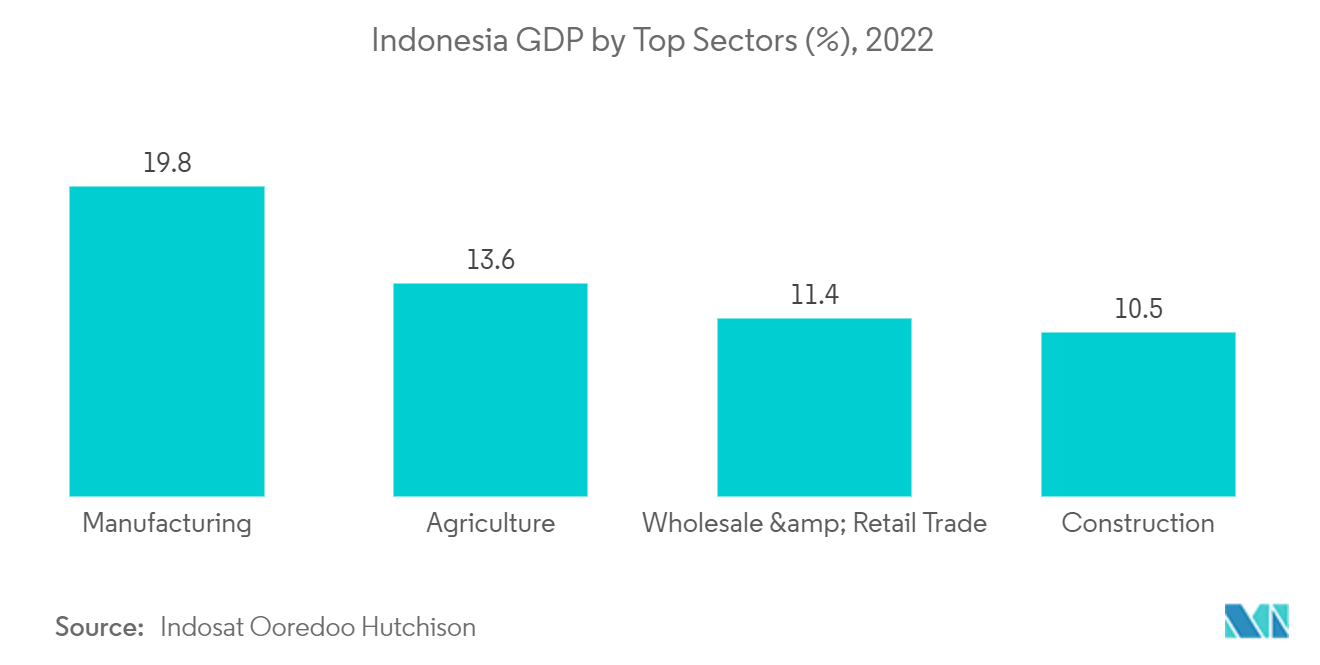
Indonesia IoT Industry Overview
The Indonesia IoT Market is fragmented because of the presence of several companies. Some key players are Accenture, Microsoft, Hewlett Packard Enterprise Development LP, Fujitsu, Toshiba, IT-Services Corporation, Oracle, Intel Corporation, Google LLC, Amazon Web Services, Inc., SAP SE, etc. Key players in this market are introducing new innovative solutions and forming partnerships and collaborations to gain competitive advantages.
- In August 2023, Amdocs, a provider of software and services to communications and media companies, deployed a next-generation IoT Connectivity Management Platform at Telkomsel, a service provider in Indonesia, enabling Telkomsel to expand its range of IoT offerings for consumer and enterprise customers. Amdocs provided system integration services to implement software provider MAVOCO's IoT Connectivity Management Platform. The Amdocs platform will allow the service provider to accommodate enterprise customers' needs better.
- In August 2022, Toshiba Energy Systems & Solutions Corporation collaborated with Indonesia's PT Geo Dipa Energi (Persero) for an IoT service to improve the utilization rate of the power generation facilities at its geothermal power plant. The IoT service includes predictive failure diagnosis and performance monitoring of power plants. The service employs the EtaPRO, a software suite acquired by Toshiba ESS that uses AI to analyze real-time operation data obtained from sensors and detect anomalies that may cause problems during power plant operation.
Indonesia IoT Market Leaders
-
Accenture
-
Microsoft
-
Hewlett Packard Enterprise Development LP
-
Fujitsu
-
Toshiba IT-Services Corporation
- *Disclaimer: Major Players sorted in no particular order
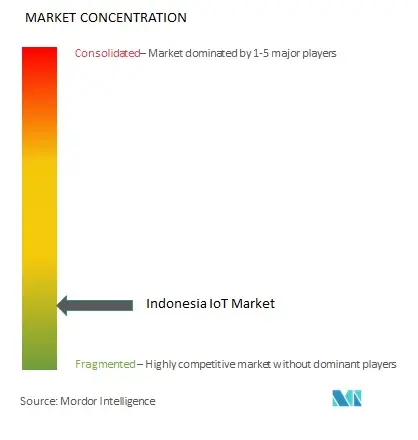
Indonesia IoT Market News
- September 2023: SDMC, an over-the-top solution provider, developed a Smart Home IoT Solution built on Google Cloud for Advan, an electronics company in Indonesia. SDMC uses Google Cloud Vertex AI's platform to develop HomeBrain, a comprehensive large language model (LLM) for smart homes. SDMC leverages Google's text-to-speech (TTS) and speech-to-text technology (STT) to create an AI voice assistant tool that can run on multiple devices. SDMC also upgraded its smart home IoT management platform, XHome, which features voice control, active learning, and service capabilities that give users precise decision-making abilities while enhancing efficiency.
- March 2023: FunP Innovation Group, a Taiwanese conglomerate specializing in digital advertising and technology, secured USD 3.12 million in funding from Ennoconn Corporation to develop innovative retail and cloud solutions in Indonesia. Ennoconn's AIoT, cloud computing, and marketing technology develop pioneering retail solutions for Indonesia, helping the company to increase its footprint in one of the fastest-growing markets in the world.
Indonesia IoT Industry Segmentation
The Internet of Things (IoT) is a network of connected devices and related technologies that facilitates communication between various devices and the cloud and between devices. IoT services represent end-to-end services that enable organizations to collaborate with external providers to design, build, and operate IoT solutions and consulting for IoT planning.
The Indonesia IoT market is segmented by type (hardware, software, and services), by application (automotive IoT, consumer IoT, healthcare IoT, industrial IoT, smart cities, and other applications), by region (Java, Sumatra, Kalimantan, and other regions).
The market sizes and forecasts are provided in terms of value (USD) for all the above segments.
| By Type | Hardware |
| Software | |
| Services | |
| By Application | Automotive IoT |
| Consumer IoT | |
| Healthcare IoT | |
| Industrial IoT | |
| Smart Cities | |
| Others | |
| By Region | Java |
| Sumatra | |
| Kalimantan | |
| Others |
Indonesia IoT Market Research FAQs
How big is the Indonesia IoT Market?
The Indonesia IoT Market size is expected to reach USD 13.05 billion in 2025 and grow at a CAGR of 15.21% to reach USD 26.50 billion by 2030.
What is the current Indonesia IoT Market size?
In 2025, the Indonesia IoT Market size is expected to reach USD 13.05 billion.
Who are the key players in Indonesia IoT Market?
Accenture, Microsoft, Hewlett Packard Enterprise Development LP, Fujitsu and Toshiba IT-Services Corporation are the major companies operating in the Indonesia IoT Market.
What years does this Indonesia IoT Market cover, and what was the market size in 2024?
In 2024, the Indonesia IoT Market size was estimated at USD 11.07 billion. The report covers the Indonesia IoT Market historical market size for years: 2019, 2020, 2021, 2022, 2023 and 2024. The report also forecasts the Indonesia IoT Market size for years: 2025, 2026, 2027, 2028, 2029 and 2030.
Indonesia IoT Industry Report
Statistics for the 2025 Indonesia IoT market share, size and revenue growth rate, created by Mordor Intelligence™ Industry Reports. Indonesia IoT analysis includes a market forecast outlook for 2025 to 2030 and historical overview. Get a sample of this industry analysis as a free report PDF download.



